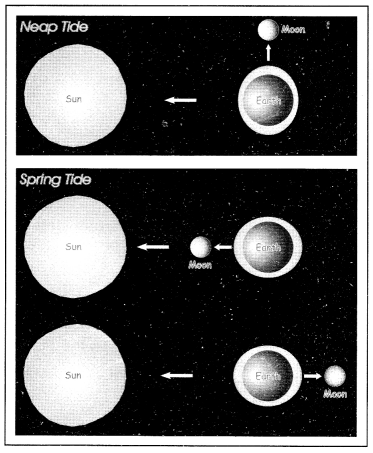Water Class 7 Geography Chapter 5 Extra Questions and Answers Social Science CBSE Pdf free download are part of Extra Questions for Class 7 Social Science. Here we have given NCERT Extra Questions for Class 7 Social Science SST Geography Chapter 5 Water.
You can also practice NCERT Solutions for Class 7 Geography Chapter 5 Questions and Answers on LearnInsta.com.
Class 7 Geography Chapter 5 Extra Questions and Answers Water
Water Class 7 Extra Questions and Answer Geography Chapter 5 Very Short Answers Type
Question 1.
How are the clouds formed?
Answer:
The sun’s heat causes evaporation of water vapour. When the water vapour cools down, it condenses and forms clouds.
Question 2.
What do you understand about water cycle?
Answer:
The process by which water continually changes its form and circulates between oceans, atmosphere and land is known as the water cycle.
Question 3.
What are the msgor sources of fresh water?
Answer:
The major sources of fresh water are the rivers, ponds, springs and glaciers.
Question 4.
Why are the oceans salty or saline?
Answer:
The water of the ocean is salty or saline because it contains large amount of dissolved salts.
Question 5.
What amount of ocean water is found on the earth?
Answer:
Ocean water is 97.3% of total water available on the earth.
Question 6.
What are the waves?
Answer:
When the water on the surface of the ocean rises and falls alternately, they are called waves.
Question 7.
How are waves formed?
Answer:
Waves are formed when gentle winds scrape across the ocean surface. The stronger the wind blows, the bigger the waves becomes.
Question 8.
What is terrarium?
Answer:
Terrarium is an artificial enclosure for keeping small house plants.
Question 9.
Where is salty water found?
Answer:
Salty water is found in oceans.
Question 10.
What is the reason of ocean water being salty?
Answer:
The ocean water contains large amount of dissolved salt. Thus, the ocean water is salty.
Question 11.
What is salinity?
Answer:
Salinity is the amount of salt in grams present in 1000 grams of water.
Question 12.
What is tide?
Answer:
The rhythmic rise and fall of ocean water twice in a day is called a tide.
Question 13.
What causes tides?
Answer:
The strong gravitational pull exerted by the sun and the moon on the earth’s surface causes the tides.
Question 14.
How are the high tides formed?
Answer:
The water of the earth closer to the moon gets pulled under the influence of the moon’s gravitational force and causes high tide.
Question 15.
How are high tides useful?
Answer:
High tides are useful because these help in navigation, fishing and also to generate the electricity.
Water Class 7 Extra Questions and Answer Geography Chapter 5 Short Answers Type
Question 1.
What is tide? Describe high and low tides.
Answer:
The rhythmic rise and fall of ocean water twice in a day is called a tide. When water covers much of the shore by rising to its highest level it is called high tide. It is low tide when water falls to its lowest level and recedes from the shore.
Question 2.
How do the ocean currents influence us?
Answer:
The ocean currents influence us because of influencing the temperature conditions of the area. The areas where the warm and cold currents meet provide the best fishing grounds of the world. Apart from this, where warm and cold currents meet provide foggy weather making navigation difficult.
Question 3.
What is Tsunami? Describe.
Answer:
Tsunami is tidal waves. In the sea storm when the winds blowing at very high speed form huge waves, tsunami is created. An earthquake, a volcanic eruption or underwater landslides can shift large amounts of ocean water. As a result huge tidal waves are formed that may be as high as 15 m.
Question 4.
State the broad categorization of ocean movements.
Answer:
The movements that occur in ocean can be broadly categorized as:
- waves
- tides and
- currents.
Water Class 7 Extra Questions and Answer Geography Chapter 5 Long Answers Type
Question 1.
How do tides originate?
Answer:
The strong gravitational pull exerted by the sun and the moon on the earth’s surface causes the tides. During the full moon and new moon days, the sun, the moon and the earth are in the same line and the tides are the highest. These tides are called spring tides.
When the moon is in its first and last quarter, the ocean waters get drawn in diagonally opposite direction by the gravitational pull of sun and earth resulting in low tides. These tides are called neap tides.
Question 2.
What are ocean currents? Describe warm and cold currents.
Answer:
Ocean currents are streams of water flowing constantly on the ocean surface in definite directions. The ocean currents may be warm or cold. Generally the warm ocean currents originate near the equator and move towards the poles. The cold currents carry water from polar or higher latitudes to tropical or lower latitudes. The ocean current influences the temperature conditions of the area.
Warm currents bring about warm temperatures over land surface. The areas where the warm and cold currents meet provide the best fishing grounds of world. The areas where a warm and cold current meet also experience foggy weather making it difficult for navigation.
Question 3.
What are Spring and Neap tides? Describe briefly withdrawing.
Answer:
During the full moon and new moon days, the sun, the moon and the earth are in the same line and the tides are the highest. These tides are called spring tides.

When the moon is in its first and last quarter, the ocean waters get drawn in diagonally opposite direction by the gravitational pull of sun and earth resulting in low tides. These tides are called neap tides.